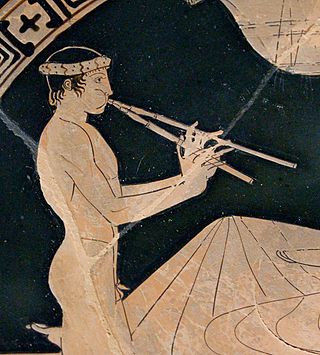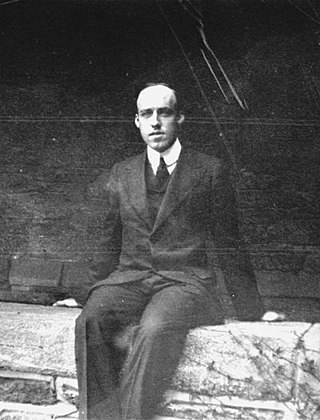Related Research Articles

The Parthenon is a former temple on the Athenian Acropolis, Greece, that was dedicated to the goddess Athena during the fifth century BC. Its decorative sculptures are considered some of the high points of Greek art, an enduring symbol of Ancient Greece, democracy and Western civilization.

An aulos or tibia (Latin) was an ancient Greek wind instrument, depicted often in art and also attested by archaeology.

The Theatre of Dionysus is an ancient Greek theatre in Athens. It is built on the south slope of the Acropolis hill, originally part of the sanctuary of Dionysus Eleuthereus. The first orchestra terrace was constructed on the site around the 4th and 5th century BC, where it hosted the City Dionysia. The theatre reached its fullest extent in the fourth century BC under the epistates of Lycurgus when it would have had a capacity of up to 25,000, and was in continuous use down to the Roman period. The theatre then fell into decay in the Byzantine era and was not identified, excavated and restored to its current condition until the nineteenth century.

The satyr play is a form of Attic theatre performance related to both comedy and tragedy. It preserves theatrical elements of dialogue, actors speaking verse, a chorus that dances and sings, masks and costumes. Its relationship to tragedy is strong; satyr plays were written by tragedians, and satyr plays were performed in the Dionysian festival following the performance of a group of three tragedies. The satyr play’s mythological-heroic stories and the style of language are similar to that of the tragedies. Its connection with comedy is also significant – it has similar plots, titles, themes, characters, and happy endings. The remarkable feature of the satyr play is the chorus of satyrs, with their costumes that focus on the phallus, and with their language, which uses wordplay, sexual innuendos, references to breasts, farting, erections, and other references that do not occur in tragedy. As Mark Griffith points out, the satyr play was "not merely a deeply traditional Dionysiac ritual, but also generally accepted as the most appropriate and satisfying conclusion to the city’s most complex and prestigious cultural event of the year."

Mabel Louise Lang was an American archaeologist and scholar of Classical Greek and Mycenaean culture.
Emily Dickinson Townsend Vermeule was an American classical scholar and archaeologist. She was a professor of classical philology and archaeology at Harvard University.
Homer Armstrong Thompson was a Canadian classical archaeologist of the twentieth century, specializing in ancient Greece. While studying for his doctorate at the University of Michigan, Benjamin Dean Meritt would introduce Thompson to the project which would occupy him for the rest of his life. The American School of Classical Studies at Athens was about to begin the excavation of the agora in Athens and Thompson was selected as a fellow of the school to aid in the project. Excavations began on May 25, 1931; Thompson would work on the excavations for the next 39 years. He was married to a fellow archaeologist Dorothy Burr Thompson.

Rhys Carpenter was an American classical art historian and professor at Bryn Mawr College.

The American School of Classical Studies at Athens (ASCSA) is one of 19 foreign archaeological institutes in Athens, Greece. It is a member of the Council of American Overseas Research Centers (CAORC). CAORC is a private not-for-profit federation of independent overseas research centers that promote advanced research, particularly in the humanities and social sciences, with focus on the conservation and recording of cultural heritage and the understanding and interpretation of modern societies.

Simon David Goldhill, FBA is Professor in Greek literature and culture and fellow and Director of Studies in Classics at King's College, Cambridge. He was previously Director of Centre for Research in the Arts, Social Sciences, and Humanities (CRASSH) at the University of Cambridge, succeeding Mary Jacobus in October 2011. He is best known for his work on Greek tragedy.

John Henry Wright was an American classical scholar born at Urumiah (Rezaieh), Persia. He earned his Bachelors (1873) and Masters (1876) at Dartmouth College, New Hampshire. After junior appointments in 1886 he joined Johns Hopkins as a professor of classical philology. In 1887, he became a professor of Greek at Harvard, where, from 1895 to 1908, he was also Dean of the Graduate School of Arts and Sciences.
The Neshmet bark was a vessel belonging to the god Nun. The ancient Egyptian deity Osiris was transported in it on the river Nile during the Osiris festival at Abydos. The god's departure from his temple, journey to his tomb, and triumphant return were enacted and drew many spectators who participated in the public parts of the mysteries.
Samuel Walter Miller, LL. D., Litt. D. was an American linguist, classics scholar and archaeologist responsible for the first American excavation in Greece and a founder of the Stanford University Classics department.

Barbara Tsakirgis was an American classical archaeologist with specialization in Greek and Roman archaeology, particularly of ancient Greek houses and households. She worked in the archaeological excavation sites in Sicily and Athens for her doctoral thesis from Princeton University on the subject of Hellenistic houses at Morgantina. Her thesis was published as The Domestic Architecture of Morgantina in the Hellenistic and Roman Periods (1984). She taught at the Vanderbilt University's Department of Classical Studies and was an associate professor from 1992 to 2019.
Ann Wheeler Harnwell Ashmead is an American archaeologist who has co-authored comprehensive catalogues with the archaeologist Etruscologist Kyle Meredith Phillips, Jr. about the Greek Vase Painting collections of Bryn Mawr College (1971) and the Rhode Island School of Design (1976). She has also written the main published catalogue for the Antiquities Collection of Haverford College (1999). and many articles on Greek Vases.
Jenifer Neils is an American classical archaeologist and since July 2017 director of the American School of Classical Studies at Athens. Formerly she was the Elsie B. Smith Professor in the Liberal Arts in the Department of Classics at Case Western Reserve University.

Elizabeth Denny Pierce Blegen was an American archaeologist, educator and writer. She excavated at sites in Greece and Cyprus, contributed reports on archaeological discoveries in Greece to the American Journal of Archaeology from 1925 to 1952, and was involved in several organisations promoting women's professional advancement in Greece and the United States.

Amy C. Smith is the current Curator of the Ure Museum of Greek Archaeology and Professor of Classical Archaeology at Reading University. She is known for her work on iconography, the history of collections, and digital museology.

The Temple of Hera or Heraion is an archaic temple in Corfu, Greece, built around 610 BC in the ancient city of Korkyra, in what is known today as Palaiopolis, and lies within the ground of the Mon Repos estate. The sanctuary of Hera at Mon Repos is considered a major temple, and one of the earliest examples of archaic Greek architecture.
Rachel Meredith Kousser is professor of art history at the City University of New York.
References
- ↑ "Miller, Margaret Christina – ID 94234921". viaf.org. Retrieved 28 May 2022.
- 1 2 "Staff Profile: Professor Margaret Miller". The University of Sydney. Retrieved 25 May 2022.
- ↑ Miller, Margaret Christina (1985), Perserie : the arts of the East in fifth-century Athens, University Microfilms International, retrieved 29 May 2022
- 1 2 3 4 "Fellow: Margaret Miller". Australian Academy of the Humanities. Retrieved 25 May 2022.
- ↑ "Project Teams". Zagora Archaeological Project. Retrieved 28 May 2022.
- ↑ "Fieldwork at Zagora". Zagora Archaeological Project. Retrieved 28 May 2022.